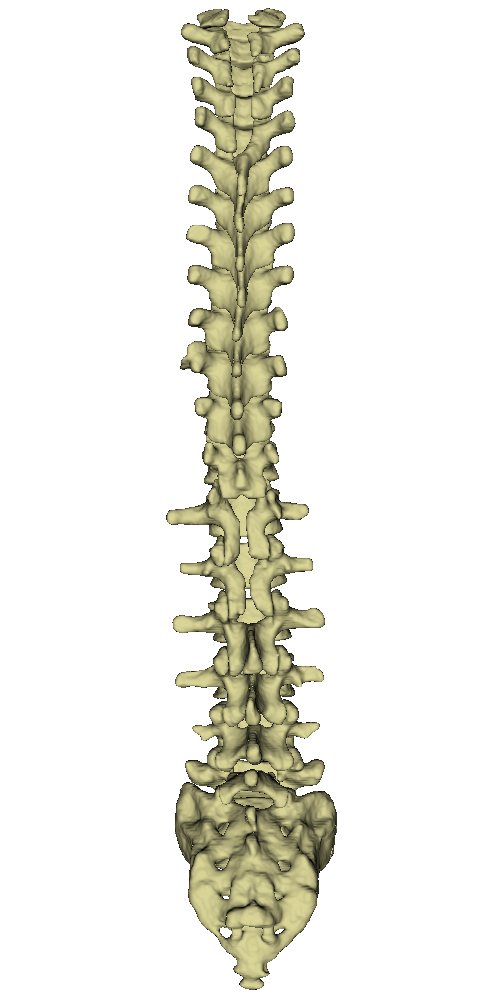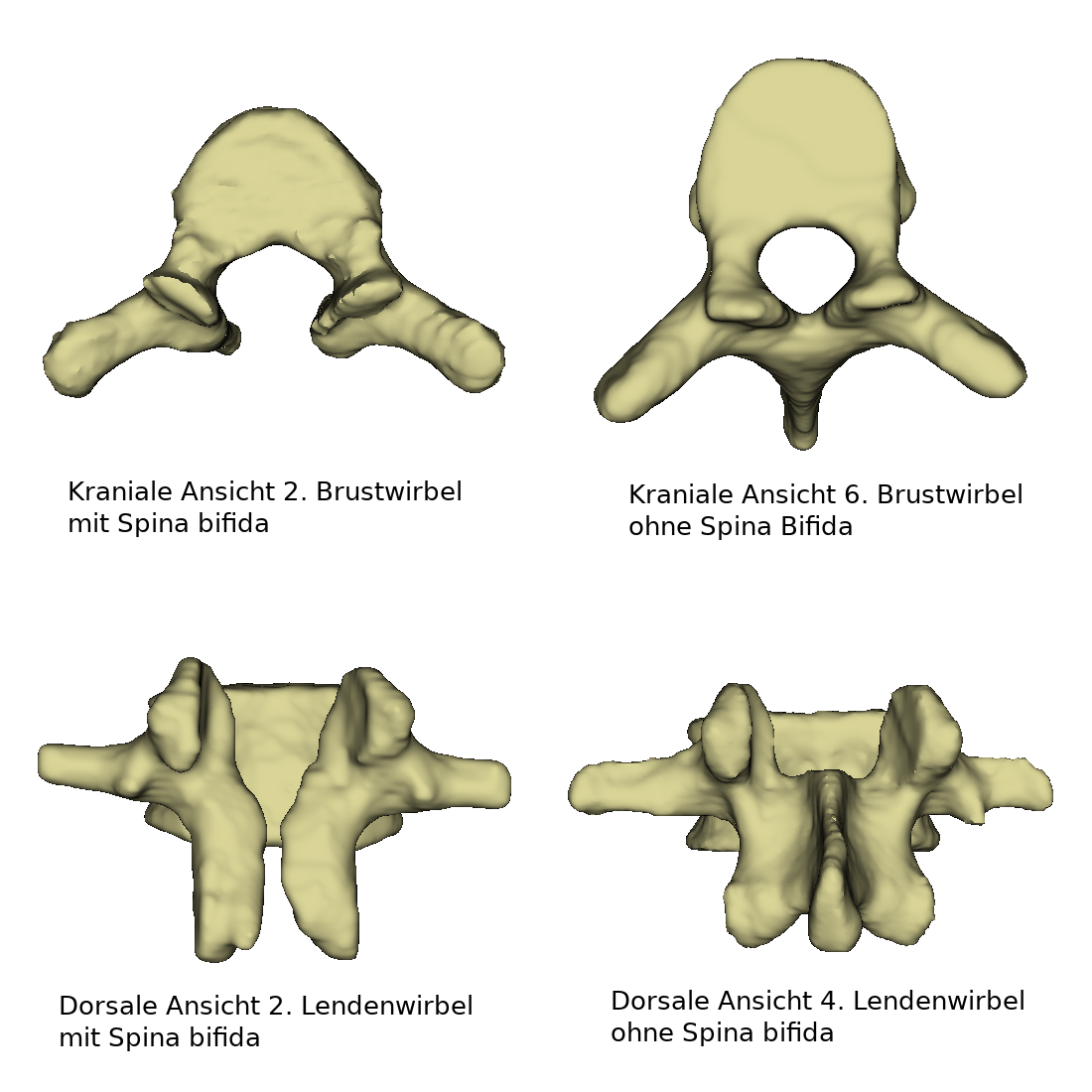Spina bifida/en: Unterschied zwischen den Versionen
(Die Seite wurde neu angelegt: „Spina bifida aperta, on the other hand, is more problematic. In spina bifida aperta, the spinal meninges and/or the spinal cord emerge from the spinal gap. Thi…“) |
(Die Seite wurde neu angelegt: „==Comparison split vertebra with healthy vertebra== <div class="thumb tright thumbinner"> <div class="picture"> <lightbox-embedding src="file:WirbelmitUntertit…“) |
||
| Zeile 37: | Zeile 37: | ||
Spina bifida aperta, on the other hand, is more problematic. In spina bifida aperta, the spinal meninges and/or the spinal cord emerge from the spinal gap. This is usually manifested by an outwardly formed sac. This is usually filled with spinal fluid. This form of spina bifida can cause severe symptoms such as paralysis of the stomach and intestines, bladder emptying disorders or even loss of pain or sensitivity disorders. Spina bifida aperta is surgically corrected immediately after birth. In some clinics, this correction can already be performed prenatally. | Spina bifida aperta, on the other hand, is more problematic. In spina bifida aperta, the spinal meninges and/or the spinal cord emerge from the spinal gap. This is usually manifested by an outwardly formed sac. This is usually filled with spinal fluid. This form of spina bifida can cause severe symptoms such as paralysis of the stomach and intestines, bladder emptying disorders or even loss of pain or sensitivity disorders. Spina bifida aperta is surgically corrected immediately after birth. In some clinics, this correction can already be performed prenatally. | ||
| − | == | + | ==Comparison split vertebra with healthy vertebra== |
<div class="thumb tright thumbinner"> | <div class="thumb tright thumbinner"> | ||
<div class="picture"> | <div class="picture"> | ||
| − | <lightbox-embedding src="file:WirbelmitUntertitel.png" group="image-group-1" caption=" | + | <lightbox-embedding src="file:WirbelmitUntertitel.png" group="image-group-1" caption="Comparison split vertebra with healthy vertebra" width="400" height="300" style="width:300px; height:300px;float:left;margin:1px;background-color:#fff;border:1px solid #c8ccd1;display: flex;justify-content: center;"/> |
</div> | </div> | ||
<div class="thumbcaption"> | <div class="thumbcaption"> | ||
| − | + | Comparison split vertebra with healthy vertebra</div> | |
</div> | </div> | ||
Version vom 29. Mai 2020, 07:42 Uhr
Spina bifida, colloquially "open back", is a congenital malformation of the spine. The spinal cord is not completely enclosed by the vertebral arch and the spinal membranes can emerge from the spinal canal.
Inhaltsverzeichnis
Reason
Spina bifida is a neural tube defect. It develops approximately in the third to fourth week of pregnancy. A vertebral gap occurs when there is an occlusion disorder in the lower section of the neural tube. This means that the two curved parts of the vertebrae do not fuse. Thus, the bony ring of vertebral body and vertebral arch around the vertebral hole is not closed. This results in a gap in the vertebra. This can be so pronounced that the spinous processes are missing in one or more vertebrae. The vertebrae of the lumbar spine and sacrum are affected significantly more often than the thoracic and cervical spine.
Shapes
The open back can occur in two forms. In spina bifida occulta, the vertebral arches are split, but the spinal cord does not emerge from the opening and is therefore unsplit. In this form there are often no symptoms and it is usually discovered by chance through X-rays.
.
Spina bifida aperta, on the other hand, is more problematic. In spina bifida aperta, the spinal meninges and/or the spinal cord emerge from the spinal gap. This is usually manifested by an outwardly formed sac. This is usually filled with spinal fluid. This form of spina bifida can cause severe symptoms such as paralysis of the stomach and intestines, bladder emptying disorders or even loss of pain or sensitivity disorders. Spina bifida aperta is surgically corrected immediately after birth. In some clinics, this correction can already be performed prenatally.
Comparison split vertebra with healthy vertebra
Die oberen Bilder zeigen jeweils einen Brustwirbel. Der linke, zweite Brustwirbel, weist eine Spina bifida auf. Dieser ist so ausgeprägt, dass kein Dornfortsatz vorhanden ist und Das Wirbelloch weit offen steht. Als Vergleich dazu steht daneben der sechste Brustwirbel der selben Wirbelsäule. Dieser hat einen ausgeprägten Dornfortsatz.
Die zweite Reihe zeigt je einen Lendenwirbel. Links ist der zweite Lenden Wirbel mit einem Wirbelspalt dargestellt. Daneben ist der vierte Lendenwirbel zu sehen. dieser ist voll ausgeprägt.
Alle diese Wirbel entstammen aus einer Wirbelsäule (zusehen in der oberen Abbildung). Bei dieser Wirbelsäule fanden sich sowohl im Brustwirbel- als auch im Lendenwirbelbereich Spaltwirbel. Des Weiteren ist bei der Abbildung dieser Wirbelsäule zu beachten, dass der Bereich der Halswirbelsäule nicht vollständig dargestellt ist. Im Bereich zwischen Lenden- und Sakralwirbeln liegt außerdem eine Lumbalisation vor. So ist in der Wirbelsäule ein sechster Lendenwirbel erkennbar.

